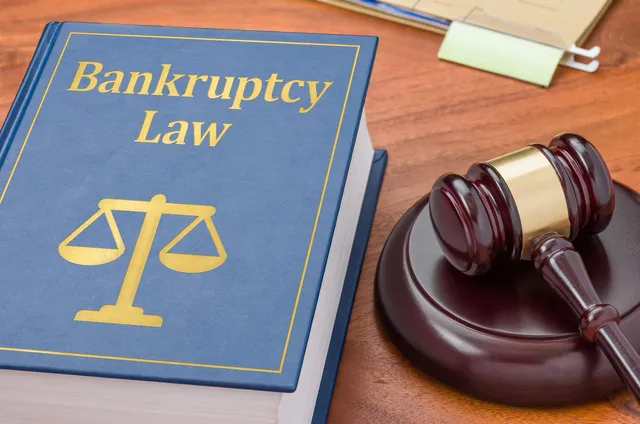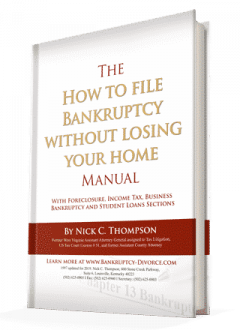There is a Chapter 13 for individuals with a steady income who wish or are required to repay debts. There is a Chapter 7 bankruptcy for businesses where business assets are liquidated. But consumers in a Chapter 7 bankruptcy are rarely lose assets.
A Chapter 20 bankruptcy is a strategy to eliminate unsecured debts before you file a Chapter 13. This makes your plan percentage higher and lowers your monthly payment in Chapter 13 if you have unsecured debt.
How a Chapter 20 bankruptcy saves you money
Imagine 30,000 in credit card debt which is often repaid at 50 tp 70% in a Chapter 13 bankruptcy. Spending about 1600 to file a Chapter 7 first before you file a Chapter 13 bankruptcy would save you 14,200 dollars if you would have to repay 30,000 at 50% to the unsecured in Chapter 13.
By discharging unsecured first there are little or no claims which have to be repaid in Chapter 13. Chapter 13 often only has to repay or catch up on secured debts like car loan arrearage, mortgage, and priority debts. A priority debt may be a recent income tax debt that must be repaid and can not be discharged.
Chapter 20 bankruptcy helps you qualify for a Chapter 13
The debtor limit used to be about 1.4 million for a 13. You could not have more than 340,000 dollars in unsecured claims. Now the Debt limit for Chapter 13 is 2.75 million. But prior to late 2022, some people had to file a Chapter 7 first and eliminate the unsecured debt before they filed a Chapter 13 because they were over the debt limits.
Chapter 20 Bankruptcy is still often needed however to make the plan more affordable or as the bankruptcy code calls it feasible. The burden of paying back all the claims can make a plan impossible.
Filing a Chapter 13 bankruptcy first for medical debt.
Sometimes if you will have ongoing large medical debt you may want to file a Chapter 13 while you are reaching recovery. If you filed immediately as a 7 you would not be able to discharge the ongoing claims you will have over the next several years. By filing a 13 you can later convert your case to a 7 and the medical debt you obtained after you filed the 13 can be included in the 7 later.
Unsecured second mortgages in a Chapter 20 bankruptcy
A second mortgage which has no equity can be stripped in a Chapter 13 bankruptcy. Often these cases will not need a Chapter 7 later. But Chapter 13 which is filed first allows you to strip a second mortgage which has no equity. The unsecured claims will be discharged too but if you need to file a Chapter 7 later the waiting period is shorter than the 8 years you have to normally wait between 7s.
Properly filing multiple cases
For farmers and fishermen who have small business assets chapter 12 is for you. Chapter 11 is for persons with large debts, assets, or businesses and corporations. Chapter 26 is a strategy for filing and completing two Chapter 13 cases when a single Chapter 13 will not get the complete job done. There are strategies for filing multiple cases to reorganize the finances so a person or business can properly reorganize.
For instance, if you cannot short sale a home and get the mortgage company’s permission to sell a home for the actual value of a property, Chapter 11 allows you to complete such a sale, and immediately after the sale, you may wish to convert the Chapter 11 to a Chapter 7. This is a method to force creditors to accept a short sale.
Chapter 7 may temporarily stop a foreclosure and allow you a short period of time to attempt to modify the mortgage and discharge the unsecured debt. If Chapter 7 does not give you all you need to cure a defaulted mortgage, you may want to file a Chapter 13 to catch up on the default over time. In Chapter 13, you can often force creditors to take the payments.
Filing a Chapter 7 before a Chapter 13.
Qualifying for a Chapter 13 bankruptcy case can have issues. You must meet some standards to file Chapter 13. Filing a Chapter 7 before you file Chapter 13 can cure some Chapter 13 issues and allow a debtor to meet jurisdictional problems like meeting the debt limits. It is often cheaper for the debtor to file a Chapter 7 before Chapter 13. A Chapter 13 must be feasible, which means the plan has to be affordable, and the debtor also has to have a regular income to fund the plan.
You must have a regular income that makes the Chapter 13 plan feasible.
If you are recovering from medical problems, you may want to file a Chapter 7 case first because you cannot yet afford the Chapter 13 plan payment. Filing Chapter 7 before you file Chapter 13 often gives you time to fully recover and increase income.
Chapter 20 makes a Chapter 13 plan affordable.
Filing Chapter 7 before you file Chapter 13 can often greatly reduce your Chapter 13 plan payment. Discharging the unsecured debts first in Chapter 7 will often reduce the Chapter 13 plan payment. It is easy to repay 100% of the unsecured claims when no unsecured claims survived Chapter 7.
The higher the plan percentage pays to unsecured debts, the greater the benefits are to the debtor. If a debtor repays a 100% plan in the Western District of Kentucky, the debtor does not have to submit an annual budget and gets to keep his tax refund.
A 50%, 70%, or 100% Chapter 13 plan is often automatically approved by the court.
Each judge is different and will often automatically approve a different level of repayment. Our judge Lloyd will automatically approve a plan which repays 70% of the unsecured claims. Judges Stout and Merrill will automatically approve plans that repay 50% of the unsecured claims or more. You are automatically assumed to have proposed the plan in good faith at these repayment levels. And it is easy to repay 100% of the unsecured claims when they are zero.
Why file a Chapter 20 Bankruptcy?
Filing Chapter 20 allows you to file Chapter 13 with large unsecured debts.
You can only file a Chapter 13 if your debts are below the jurisdictional limits. In 2022 the amount of debt you could discharge in a Chapter 13 bankruptcy increased to $2,750,000. Before 2022 a Chapter 13 could only be used if your unsecured debts were less than 360,000 and the combined debt was below 1,350,000. If you had too much-unsecured debt, you could not file a Chapter 13.
Filing a Chapter 7 bankruptcy before you file Chapter 13 wiped out the unsecured debt. There is no debt limit for Chapter 7. Filing Chapter 7 first lowers the overall debt and allowed some Debtors to qualify for Chapter 13. Since the debt limit increased, this is rarely a problem, but it can happen.
Filing Chapter 20 often allows you to
Which Chapter is better, Chapter 7 or 13?
What debts are not discharged in bankruptcy?
Filing Chapter 7 gives you the discharge of unsecured debts within four months. After Chapter 7 you can often manage secured or priority debts with all the advantages of:
1. A plan which pays 100% of the unsecured debts.
2. Qualifying for a Chapter 13 when you otherwise may not have due to feasibility or jurisdictional problems.
To file bankruptcy, you can feel free to contact me


